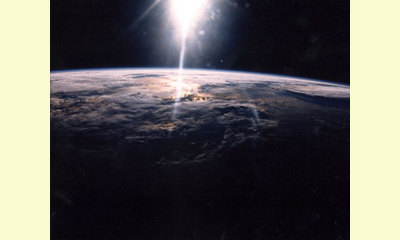|
|
World Wildlife Federation: 2012 Living Planet Report
un articulo por Jim Leape, Director General, WWF International
We are all familiar with the stark array of graphs that detail how we are sapping the Earth’s resources and resilience. This 2012 edition of the Living Planet Report tells us how it all adds up – the cumulative pressure we’re putting on the planet, and the consequent decline in the health of the forests, rivers and oceans that make our lives possible.

Photograph from space showing a view of the sun shining on Earth. Copyright NASA.
click on photo to enlarge
We are living as if we have an extra planet at our disposal. We are using 50 per cent more resources than the Earth can provide, and unless we change course that number will grow very fast – by 2030, even two planets will not be enough.
But we do have a choice. We can create a prosperous future that provides food, water and energy for the 9 or perhaps 10 billion people who will be sharing the planet in 2050.
We can produce the food we need. Solutions lie in such areas as reducing waste; using better seeds and better cultivation techniques; bringing degraded lands back into production; and changing diets – particularly by lowering meat consumption in high income countries.
We can ensure there is enough water for our needs and also conserve the healthy rivers, lakes and wetlands from which it comes. Smarter irrigation techniques and better resource planning, for example, can help us use water more efficiently.
We can meet all of our energy needs from sources like wind and sunlight that are clean and abundant. The first imperative is to get much more out of the energy we use – increasing the efficiency of our buildings, cars and factories can cut our total energy use in half.
These solutions, and others articulated within this edition of the Living Planet Report, show that we all need to play a role in keeping this a living planet – with food, water and energy for all, and the vibrant ecosystems that sustain life on Earth.
Click here for a version of this article in French or here for a version in Spanish.
|








|
DISCUSSION
Pregunta(s) relacionada(s) al artículo :
If we can connect up the planet through Internet, can't we agree to preserve the planet?
* * * * *
Comentario más reciente:
I think the Internet is a bit of a double edged sword when it comes to the environment. On the one hand it has aided in the raising of awareness of ecological issues, and many companies have had to green up their acts as a result of web-buzz.
On the other hand the World Wide Web has enabled a great deal more commerce, often with little to no regard to the ecological ramifications of that commerce.
I propose that we cease to think of the Internet as an entity that does things, and start thinking of it as a collective network devoted to moving ideas. Then ask ourselves. How do we implant ideas into this network in order to achieve our stated objective.
Why not put out a catchy YouTube video about a web purchase you made and its ecological ramifications. Why not highlight businesses that do their business in a clean and ethical manner. . ... continuación.

|
|









